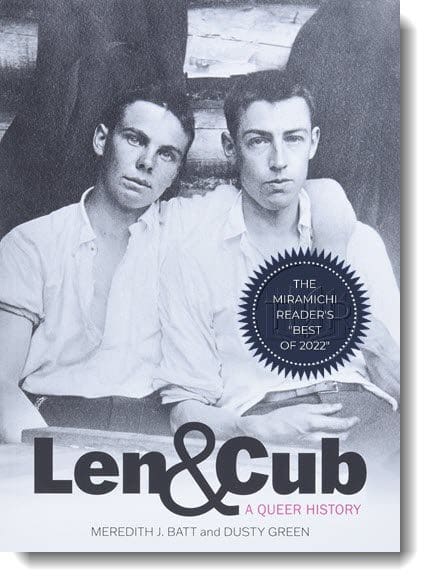In an Appendix to Len and Cub: A Queer History, Meredith J. Batt and Dusty Green note that “archival institutions have not always collected records related to queer people and in some cases have actively worked to suppress queer content in their collections.” As the authors explain, the gaps created by this process are deepened by a variety of social, religious, and cultural pressures in New Brunswick, all merging to form a longstanding silence around 2SLGBTQ+ experiences in the province. Into this representative void, Len and Cub: A Queer History maps a narrative of intimacy between two men in the rural community of Havelock. Through what Batt describes as a “great deal of care and research . . . to situate the story properly,” the text highlights a palpable and captivating love between Leonard Olive Keith and Joseph Austin “Cub” Coates.
“While all of the photographs are unbelievably special, the ways that Batt and Green frame, explain, and feature each piece are equally wonderful.”
It is not only noteworthy that Len and Cub’s relationship offers important insight into New Brunswick’s past, 2SLGBTQ+ histories, and the realities of rural life at the beginning of the twentieth century, but also that the authors have so carefully curated the men’s story. Rooted in photographs found in the provincial archives, the book develops through a loose chronological focus. After an opening reflection on language and context, attention turns to the boys’ childhood, and follows Len and Cub through experiences during adolescence and early adulthood, and beyond. While the focus of the text is the relationship between the men, Batt and Green ensure that both are also introduced as individuals with unique wants, habits, and backgrounds. The accompanying historical context allows readers to understand how distinctions in their upbringing, social positioning, and career paths influenced the events of their lives and the local community.
While aspects of their lives were separate, the men spent significant time together travelling around the countryside, visiting backwoods camps, and even serving in the First World War at the same time. Len’s photos offer amazing snippets of these moments and others, and the connection between the men is obvious. As Batt and Green note, the language for this relationship would have been different at the time and has shifted in the decades since; what is apparent, without the need for categorization, is a deep affection between two men who loved to explore their shared surroundings together.
There are several images in the book that takes my breath away. In one, titled “Cub and Len in the dappled light of a summer’s afternoon at the Keith house,” the men lay in a hammock; their upper bodies lean at either end, and their heads rest casually in their hands. Their legs touch, bunched together in the centre of the hammock. They look directly out from the page and into the eye of the viewer. Len holds what looks to be an apple and has the whisper of a smile on his face. This image spans two full pages, working as a kind-of centrefold for the text. When the page is turned, readers are introduced to another photograph of the men in the hammock; here, they lean into each other as they light cigarettes.
There is something arresting in the movement from the two-page image to the accompanying photo, which is paired with the chapter titled: “The Love That Dare Not Speak Its Name.” As the introduction to the chapter notes, “over time this friendship became deeper than boyhood camaraderie. The exact details of why they gravitated towards each other have been lost to time, but from the photos, it is possible to glean information about their relationship by looking for clues in the settings, poses and demeanour, dates, subjects, and garb. This information was then corroborated by travel documents and news clippings, while simultaneously being interpreted through a queer lens. Through that lens, the deep connection and love between Len and Cub is evident in the hundreds of photos documenting their relationship.” This passage is worth quoting at length as it demonstrates how Batt and Green weave description, interpretation, evidence, and approach together for readers in a way that is easily accessible and affective.
While all of the photographs are unbelievably special, the ways that Batt and Green frame, explain, and feature each piece are equally wonderful. Throughout, the effort put into research and contextualization is evident as the text brings together theories of gender and sexuality, histories of sexuality from a broader context, and local or national histories of farming, automobiles, war, and other topics. This research rests alongside a variety of more ephemeral documents like newspapers, advertisements, and diaries that, where possible, fill in the specificities of the men’s lives and help readers understand the constraints around desire in New Brunswick in this period. In this way, Len and Cub: A Queer History will appeal to a variety of readers: those interested in the histories of the province and wider Maritime region, those who enjoy viewing beautifully curated photographs, and those who want a fuller understanding of sexuality in New Brunswick and Canada, and more.
These histories—not only of rural queer love generally but also of non-conforming relationships specific to the Atlantic Canadian past—are to be treasured. As Green writes in the Foreword: “Over time I became aware of the often-touted phrase in queer circles, “We have always been here.” I knew that we, queer people, had always existed, but the here never clicked for me.” They go on to note that, along with other pressing issues, a lack of representation of queer love in New Brunswick led to their own feelings of isolation. In response, Len and Cub: A Queer History artfully and with intention says ‘these stories and experiences are here.’ It all comes down to the finding and the telling. Overall, while centring Len and Cub’s relationship in the necessary historical and geographic context, Batt and Green underscore the importance of the men’s legacy and offer a compassionate, poignant, and beautiful tribute to 2SLGBTQ+ people of the past and the unfolding present.
Meredith J. Batt (they/them) grew up in Sackville/Moncton and earned a BA in history at the Université de Moncton. They currently work as an archivist at the Provincial Archives of New Brunswick in Fredericton. Their writing has appeared in Xtra Magazine, the Canadian Historical Review, and Active History.
Dusty Green (he/they) grew up in northwest New Brunswick and holds degrees from St. Thomas University and the New Brunswick College of Craft and Design. Green has previously worked at the New Brunswick Provincial Archives and Fredericton Region Museum. He is currently manager of communications and marketing at the New Brunswick Lung Association. While working at the Provincial Archives, Green came across the photos of Len and Cub and created a photo book that would be the precursor of Len & Cub: A Queer History.
- Publisher : Goose Lane Editions (April 5 2022)
- Language : English
- Paperback : 192 pages
- ISBN-10 : 1773102648
- ISBN-13 : 978-1773102641
*The Miramichi Reader encourages you to shop independent! However, shopping at a bookstore is not always possible, so we are supplying an Amazon.ca link. Please note if you choose to purchase this book (or Kindle version) through Amazon using the link below we will receive a small commission at no extra cost to you. If you cannot see the Amazon ad below (if you are using an ad blocker, for instance) here is the link: https://amzn.to/3MBYOyl Thanks!
Gemma Marr (she/her) was born and raised in rural New Brunswick. After over a decade away, she is excited to return to the province to teach in the Department of Humanities and Languages at the University of New Brunswick Saint John. Her research focuses on the intersections of place, gender, and sexuality in Atlantic Canadian literature and culture. She is an avid reader and writer who enjoys books from a range of genres and styles.










